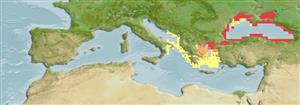>
Gobiiformes (Gobies) >
Gobiidae (Gobies) > Gobiinae
Etymology: Proterorhinus: Greek, proteros = former + Greek, rhinos = nose (Ref. 45335).
More on author: Pallas.
Issue
Name should be changed to Proterorhinus semilunaris Heckel 1837 according to: Stepien C.A. & M.A. Tumeo, 2006: Invasion Genetics of Ponto-Caspian Gobies in the Great Lakes: A ‘Cryptic’ Species, Absence of Founder Effects, and Comparative Risk Analy
Environment: milieu / climate zone / Tiefenbereich / distribution range
Ökologie
seewasser; süßwasser; brackwasser demersal; pH range: 7.0 - 7.5; dH range: 10 - ?; amphidrom (Ref. 46888). Temperate; 4°C - 18°C (Ref. 2060); 60°N - 36°N, 17°E - 54°E
Eurasia: rivers and estuaries of Black Sea, Sea of Azov and Caspian Sea, including tributaries. In the Mediterranean, occurs only in the Evros and Strymon systems, which empty in the northern Aegean Sea.
Size / Gewicht / Alter
Geschlechtsreife: Lm ? range ? - ? cm
Max length : 11.5 cm TL Männchen/unbestimmt; (Ref. 2058)
Rückenflossenstacheln (insgesamt) : 7 - 8; Rückenflossenweichstrahlen (insgesamt) : 14 - 18; Afterflossenstacheln: 1; Afterflossenweichstrahlen: 12 - 15. Seven transverse suborbital rows, complete oculoscapular and preopercular lateral-line canals, scaled nape and as a distinctive autapomorphy, an elongate anterior nostril, which extends over the upper lip. Broad dark oblique banding across the body.
Body shape (shape guide): fusiform / normal; Cross section: circular.
Pure inhabitant of brackish waters (Ref. 92840). Occur in rivers and estuaries (Ref. 4696). Based on morphological and molecular data, this species does not enter pure freshwater and inhabits brackish waters in Sevastopol, Crimea (Ref. 59043).
Miller, P.J., 1990. The endurance of endemism: the Mediterranean freshwater gobies and their prospects for survival. J. Fish Biol. 37(Suppl.A):145-156. (Ref. 12215)
IUCN Rote Liste Status (Ref. 130435: Version 2025-1)
Bedrohung für Menschen
Harmless
Nutzung durch Menschen
Fischereien: kommerziell; Aquarium: Kommerziell
Tools
Zusatzinformationen
Download XML
Internet Quellen
Estimates based on models
Preferred temperature (Ref.
123201): 11 - 18.3, mean 13.9 °C (based on 80 cells).
Phylogenetic diversity index (Ref.
82804): PD
50 = 0.5156 [Uniqueness, from 0.5 = low to 2.0 = high].
Bayesian length-weight: a=0.01000 (0.00601 - 0.01665), b=3.08 (2.94 - 3.22), in cm total length, based on LWR estimates for this species & (Sub)family-body (Ref.
93245).
Trophic level (Ref.
69278): 3.5 ±0.5 se; based on diet studies.
Widerstandsfähigkeit (Ref.
120179): hoch, Verdopplung der Population dauert weniger als 15 Monate. (Assuming tm<=1).
Fishing Vulnerability (Ref.
59153): Low vulnerability (10 of 100).
🛈
